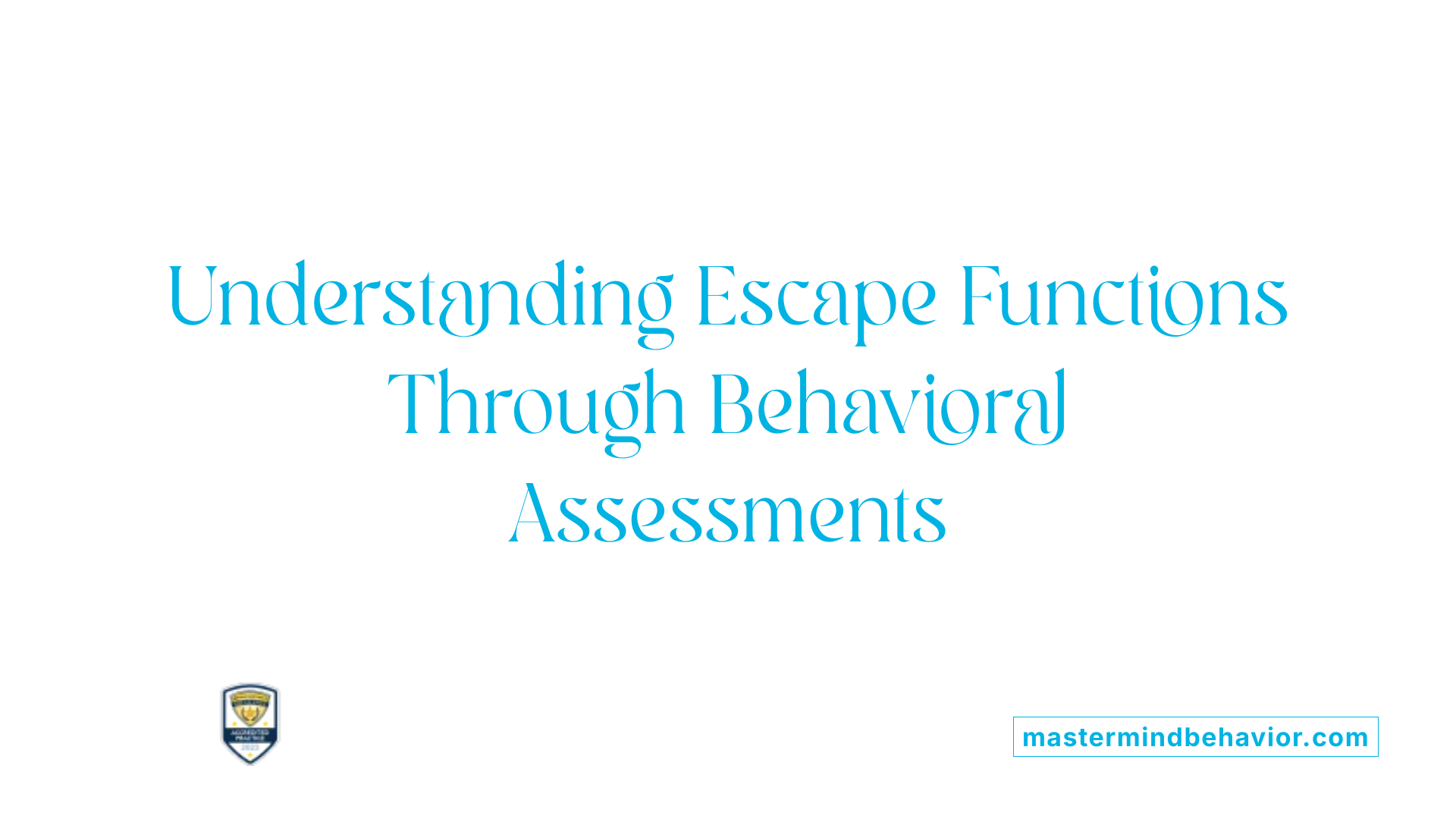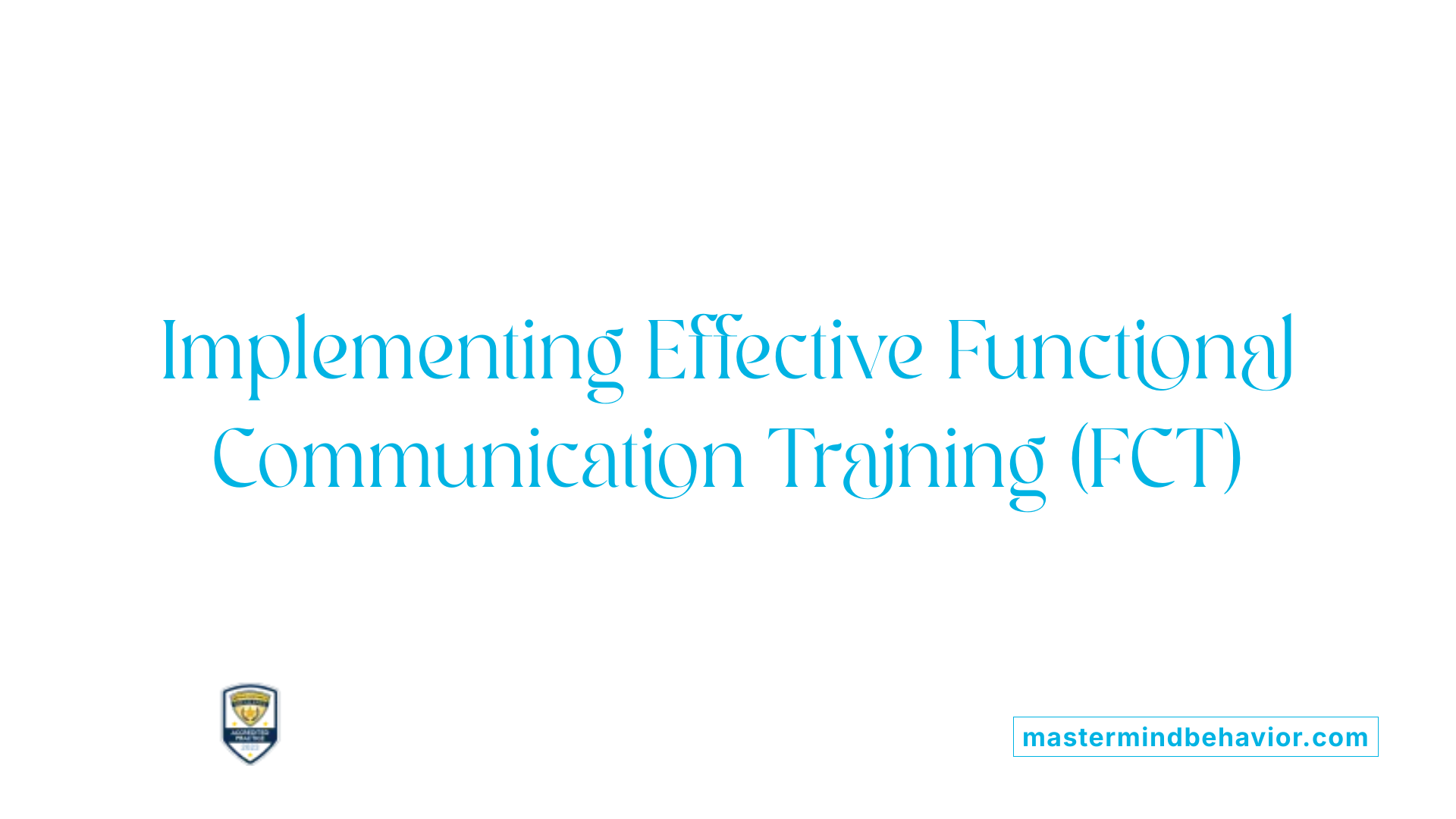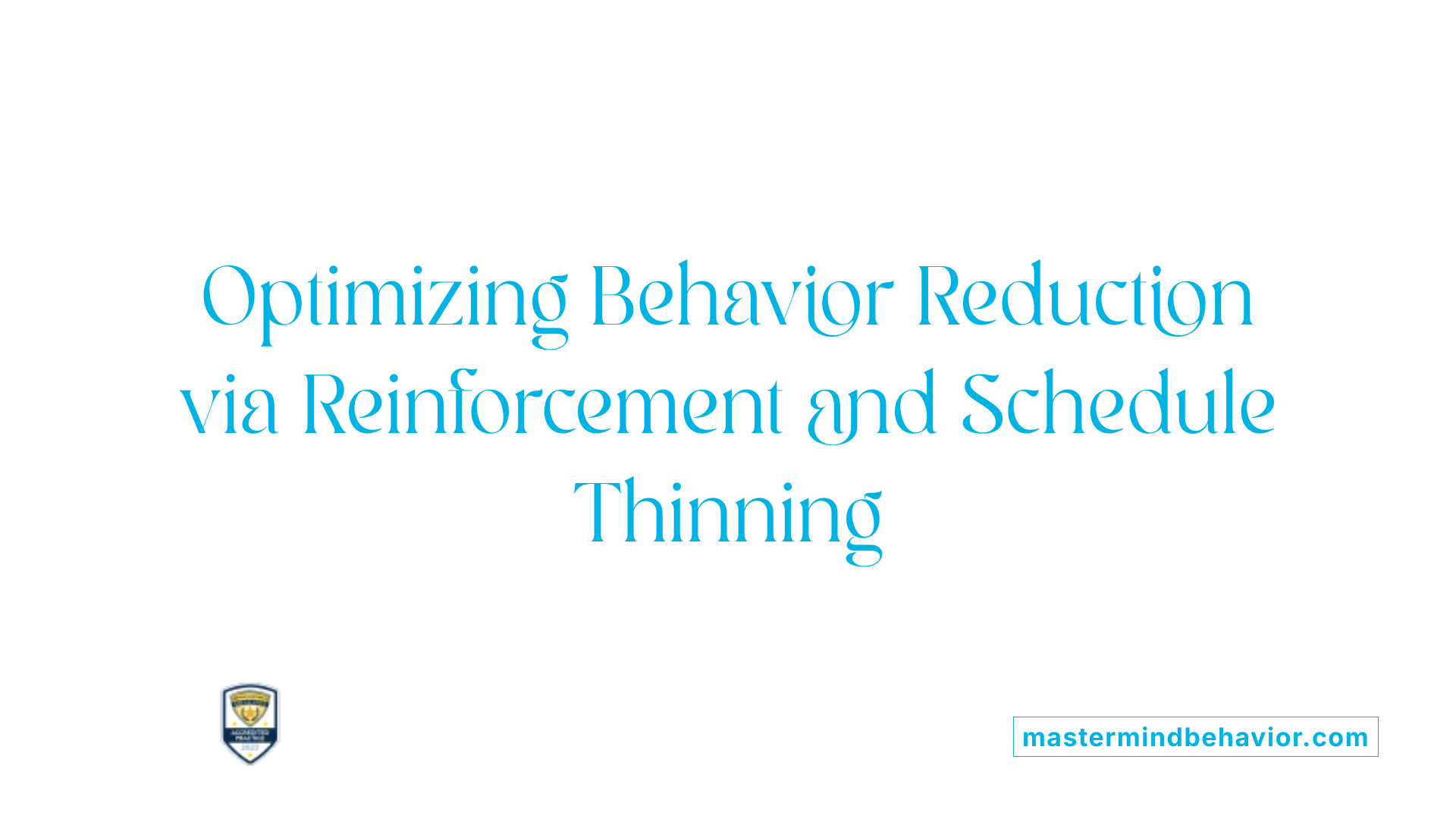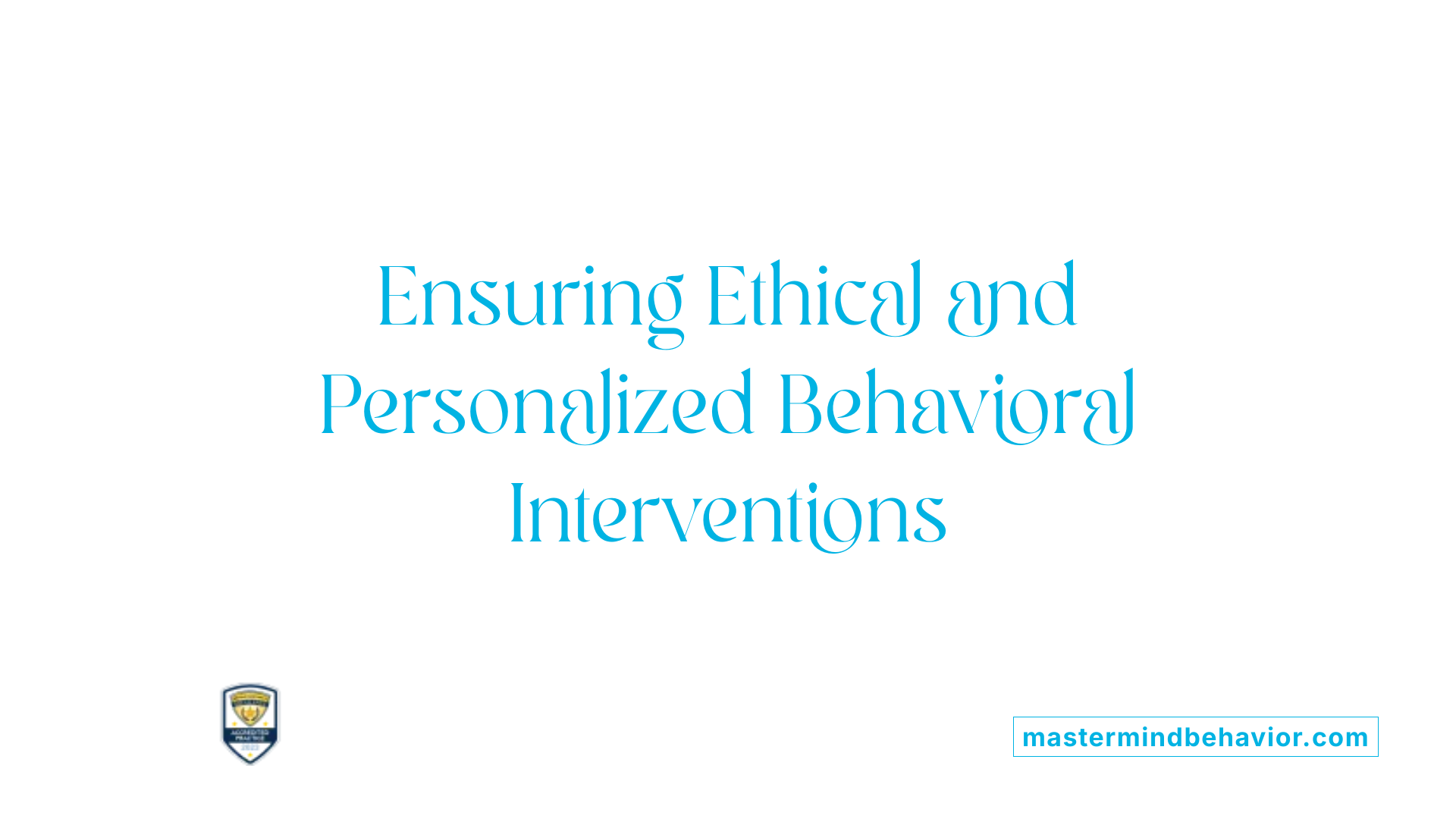ABA Therapy To Reduce Escape Maintained Behaviors

Understanding and Reducing Escape-Maintained Problem Behaviors in ABA Therapy
Escape-maintained behaviors pose significant challenges in behavioral intervention, especially for individuals with autism spectrum disorder (ASD) and other developmental disabilities. Applied Behavior Analysis (ABA) offers a robust framework for assessing the function of such behaviors and implementing targeted strategies to reduce them. This article delves into the most researched, function-based treatments for escape-maintained behaviors, exploring assessment techniques, intervention methods, and the role of reinforcement—both positive and negative—in fostering adaptive behaviors.
Understanding the Foundation: Functional Analysis and Behavior Assessment
 Functional behavior assessment (FBA) and functional analysis (FA) are crucial tools in ABA therapy for understanding challenging behaviors maintained by escape. These assessments help determine whether escape from demands or other aversive stimuli is the primary reason a behavior occurs.
Functional behavior assessment (FBA) and functional analysis (FA) are crucial tools in ABA therapy for understanding challenging behaviors maintained by escape. These assessments help determine whether escape from demands or other aversive stimuli is the primary reason a behavior occurs.
Functional analysis involves systematically manipulating environmental variables to observe how behaviors change in response. By introducing or removing specific antecedents and consequences, clinicians can identify if a behavior is reinforced by negative reinforcement—such as escaping an unwanted task—or by other factors like gaining attention or access to preferred items.
Confirming the escape function through systematic evaluation ensures that interventions are accurately targeted. For example, if a child's problem behavior decreases when demands are removed, it indicates escape-maintained behavior. Conversely, if behaviors persist despite demand removal, other functions may need exploration.
Behavior assessment guides intervention by helping clinicians develop tailored strategies. Knowing that a behavior is escape-maintained allows for the implementation of effective treatments like functional communication training (FCT), which teaches the individual to request breaks or help appropriately.
Through ongoing data collection, professionals can monitor the effectiveness of interventions, adjusting them as needed to reduce escape-motivated behaviors. Tasks such as schedule thinning, demand fading, and embedding alternative reinforcement during reinforcement intervals are informed directly by assessment findings.
Overall, within ABA therapy, understanding whether a behavior is maintained by escape guides the choice of the most appropriate and ethical intervention tools, ensuring support is personalized and effective.
What is the role of behavior assessment in guiding interventions for escape-maintained behaviors?
Behavior assessment, especially through functional analysis and functional behavior assessment (FBA), is essential for pinpointing the precise function of escape-maintained behaviors. It reveals whether behaviors serve to avoid discomfort, demands, or aversive stimuli. This knowledge allows clinicians to design interventions that directly address the underlying need, such as teaching alternative communication or adjusting environmental factors, ultimately fostering adaptive behaviors and reducing problematic escape behaviors.
Function-Based Interventions for Escape Behaviors

How is Functional Communication Training (FCT) developed and implemented?
Functional Communication Training (FCT) is based on the results of a functional analysis (FA), which identifies the environmental variables maintaining problem behavior. During FA, specific antecedents and consequences are systematically manipulated to confirm if escape from tasks or activities sustains the challenging behavior.
Once the function of the behavior, such as escape, is established, FCT teaches individuals to communicate their need for a break, help, or other support through a functional communication response (FCR). The FCR is reinforced consistently, replacing the problematic behavior with a more appropriate way to request escape or accommodations. Implementation involves teaching the individual the FCR in natural settings, providing ample reinforcement, and gradually fading prompts for independence.
What is the role of scheduled breaks, noncontingent escape, and demand fading?
Scheduled breaks are used initially with a dense reinforcement schedule, often involving noncontingent escape (NCE), where breaks are provided based on time rather than behavior. This approach helps establish a positive association with breaks and reduces the motivation for escape-maintained behaviors.
As treatment progresses, demand fading is used to systematically reintroduce instructional tasks after removing or reducing demands. This involves gradually increasing task difficulty or duration and carefully fading the amount of free time or breaks provided. When combined with escape extinction—where escape is not granted for problem behavior—these strategies help decrease escape-maintained problem behaviors and increase task engagement.
How can interventions be tailored to individual needs?
Customization is essential for success. Behavior analysts assess each individual’s specific triggers, preferences, and environmental context. By doing so, they design interventions that include preferred activities to serve as motivators and control environmental variables.
Adjustments may include offering choices between tasks, modifying task parameters, and embedding preferred stimuli within the activity. The use of chained schedules, where completion of a work sequence leads to reinforcement, and schedule thinning to make reinforcement less frequent are practical methods to promote natural task engagement and minimize escape behaviors.
What treatment options are available in ABA therapy for managing escape-maintained problem behaviors?
In ABA therapy, managing escape-maintained behaviors involves several evidence-based strategies. Treatment options include:
- Functional Communication Training (FCT): Teaching individuals to request breaks appropriately.
- Antecedent modifications: Adjusting task difficulty, providing choices, or incorporating preferred activities.
- Reinforcement-based procedures: Using differential reinforcement of alternative behaviors (DRA), noncontingent escape, and extinction of problem behaviors.
- Chained schedules and schedule thinning: Systematically increasing independence and minimizing escape-maintained behaviors.
Combining these approaches creates a comprehensive treatment plan that reduces problem behavior while promoting adaptive communication and compliance, improving overall quality of life.
The Role of Reinforcement and Schedule Thinning in Behavior Reduction

How does negative reinforcement work in ABA therapy to reduce escape-maintained behaviors?
Negative reinforcement in ABA therapy functions by strategically removing or avoiding aversive stimuli immediately after the individual demonstrates a desired behavior. This process increases the likelihood that the behavior will occur again because it results in the removal of discomfort, frustration, or other undesirable stimuli. For example, allowing a child to leave an unpleasant task after some engagement can reinforce escape behavior by making relief from the task contingent on specific responses.
Over time, this method teaches individuals that engaging in appropriate behaviors can effectively reduce or prevent discomfort, leading to decreased escape-maintained behaviors. It is important to apply negative reinforcement ethically, ensuring that the removal of discomfort is compassionate, safe, and accompanied by teaching alternative, functional responses. This approach not only helps reduce problematic behaviors but also supports skill development, making responses more adaptive and appropriate in various contexts.
Overall, negative reinforcement works by leveraging the removal of aversive stimuli to reinforce positive, functional responses, ultimately promoting independence and improved quality of life for individuals with escape-maintained issues.
Chained Schedules and Embedded Reinforcement Techniques

How do chained schedules involving work tasks and reinforcement access work?
Chained schedules are structured sequences where individuals must complete a series of tasks or work components before gaining access to reinforcement. In practice, this could mean finishing a set of academic exercises, chores, or activities in a specific order. Once all steps are completed, the individual earns access to reinforcement, such as a preferred activity or break. This approach ensures that the reinforcement is contingent on task completion, promoting task engagement and reducing problematic escape behaviors.
What is the role of embedded alternative reinforcement within these schedules?
Embedding alternative reinforcement during the schedule involves providing opportunities for desirable behaviors to be rewarded within the ongoing task sequence. Instead of only rewarding the end of a chain, reinforcement or prompts can be presented cumulatively or intermittently within the schedule. This method increases the frequency of adaptive behaviors, helps reinforce engagement, and reduces frustration associated with waiting for the final reinforcement. Embedding reinforcement encourages individuals to stay engaged with tasks and diminishes the likelihood of escape or disruptive behaviors.
How does the combined use of reinforcement strategies compare to escape-only interventions?
Research shows that integrating reinforcement for appropriate behaviors within chained schedules, especially with embedded alternative reinforcement, outperforms escape-only methods. When reinforcement is delivered for adaptive responses at multiple points, individuals demonstrate lower rates of problem behavior, higher compliance, and more efficient progress during schedule thinning. These combined approaches foster independence and task persistence, making interventions more practical and effective.
How does negative reinforcement work in ABA therapy to reduce escape-maintained behaviors?
Negative reinforcement in ABA works by removing or avoiding an unwanted or aversive stimulus immediately after a desirable behavior occurs. For instance, allowing a person to leave a task after some effort teaches that engaging in appropriate behaviors can reduce discomfort or escape the demand, increasing the likelihood of such behaviors in the future. Ethical application involves ensuring that removal of discomfort is compassionate, and the goal is to teach functional skills while minimizing frustration. Over time, this method shifts focus from escape-motivated behaviors to more appropriate responses, improving overall quality of life.
What is the impact of chained schedules with embedded alternative reinforcement on reducing problem behavior?
Chained schedules with embedded reinforcement significantly lower problem behaviors by encouraging completion of tasks while simultaneously providing reinforcement for appropriate responses. This combination leads to lower escape-maintained behaviors, higher compliance, and greater independence. When reinforcement is embedded during the schedule, individuals are more likely to engage with tasks without resorting to disruptive escape behaviors. Moreover, these methods streamline the process of schedule thinning, making treatment less intrusive and more sustainable.
Ethical Considerations and Tailoring Interventions
 In applying functional communication training (FCT) and other behavioral interventions, respecting the individual’s dignity and safety is paramount. Ethical practice involves using the least restrictive methods necessary to achieve behavioral goals, ensuring that interventions do not cause harm or undue discomfort.
In applying functional communication training (FCT) and other behavioral interventions, respecting the individual’s dignity and safety is paramount. Ethical practice involves using the least restrictive methods necessary to achieve behavioral goals, ensuring that interventions do not cause harm or undue discomfort.
Personalizing treatments based on client characteristics, such as age, developmental level, and specific behavioral functions, enhances effectiveness. Tailoring strategies to meet the unique needs of each individual ensures that interventions are both respectful and practical.
Fading interventions gradually over time is another ethical consideration. Instead of maintaining constant supports, therapists systematically reduce intervention intensity, allowing individuals to develop and sustain skills independently. This process fosters autonomy while minimizing dependency on external procedures.
The ethical use of reinforcement, including negative reinforcement, is crucial. When utilized properly, negative reinforcement involves removing a negative stimulus immediately after a desired behavior occurs, increasing the likelihood of that behavior recurring. For example, allowing a child to leave a non-preferred task after demonstrating some engagement can reduce escape-maintained behaviors by demonstrating that compliance leads to relief.
To ensure safety and dignity, it is essential to implement these strategies within a framework that emphasizes compassion and respect. Fading interventions, choosing the least restrictive options, and customizing based on individual needs align with ethical principles in ABA therapy.
| Consideration | Description | Best Practice |
|---|---|---|
| Respect individual dignity | Ensure interventions do not cause harm or psychological stress | Use respectful communication and maintain individual autonomy |
| Fading interventions over time | Reduce reliance on external supports gradually to promote independence | Plan systematic fading with clear goals |
| Least restrictive methods | Use the simplest, least intrusive approach that is effective | Prioritize gentle, non-coercive techniques |
| Personalized treatments | Adapt interventions based on client’s needs, preferences, and environment | Conduct functional assessments and tailor strategies |
Understanding and adhering to these ethical guidelines ensures that behavior interventions promote not just behavioral change but also respect and dignity for the individuals involved.
Summary: Effective, Individualized Approaches to Reducing Escape Behaviors
How do evidence-based practices support reduction of escape-maintained behaviors?
Research in applied behavior analysis (ABA) highlights several effective, evidence-based methods for decreasing escape-driven problem behaviors. Functional Communication Training (FCT) stands out as a particularly effective approach. It involves conducting a thorough functional analysis (FA) to identify environmental variables maintaining the behavior, such as avoidance of specific tasks. Once the function is identified, individuals are taught a functional communication response (FCR) that serves as a socially acceptable alternative to challenging behaviors, like requesting a break.
In addition, schedules—especially those involving reinforcement—are used strategically. For example, schedule thinning gradually decreases reinforcement frequency, making behaviors more sustainable in natural environments. Embedding alternative reinforcement within reinforcement intervals further enhances treatment outcomes and can lead to more durable reductions in problem behaviors.
Why is an individualized treatment plan crucial?
Every individual’s behavior is influenced by unique environmental factors, making tailored interventions essential. Functional analysis helps confirm the behavior’s purpose—most often escape in this context—so treatments can target the specific maintaining variable. For escape-maintained problem behaviors, strategies such as demand fading, where demands are gradually reintroduced, and noncontingent escape—providing scheduled breaks—have proven effective.
These individualized plans often incorporate antecedent modifications, like adjusting task parameters and offering choices, to reduce the motivation for escape. Reinforcing alternative appropriate behaviors, such as requesting help, is fundamental. Ethical considerations, including the use of least restrictive methods and respecting dignity, shape treatment planning.
How can combining strategies lead to better outcomes?
Research suggests that combining positive and negative reinforcement during FCT facilitates faster and more complete schedule thinning. For instance, teaching individuals to communicate their need for a break and then reinforcing this request can decrease escape behaviors over time.
Chained schedules with embedded alternative reinforcement—requiring completion of work before access to reinforcement—are more effective than escape-only approaches. They lead to lower problem behavior, higher compliance, and increased treatment efficiency.
A clinical model for selecting interventions considers client characteristics, environmental constraints, and individual preferences. This comprehensive, tailored approach—integrating functional analysis, communication training, antecedent adjustments, and schedule management—provides the most robust framework for reducing escape-maintained behaviors, ultimately improving quality of life for individuals.
| Strategy | Description | Benefits |
|---|---|---|
| Functional Communication Training | Teaching communication responses to replace escape behavior | Increases socially acceptable communication, reduces problem behavior |
| Schedule Thinning | Decreasing reinforcement frequency systematically | Promotes maintenance in natural settings |
| Embedded Alternative Reinforcement | Providing reinforcement within schedules | Lowers problem behavior, boosts compliance |
| Demand Fading | Gradually reintroducing demands | Decreases escape behaviors |
| Noncontingent Escape | Providing scheduled breaks regardless of behavior | Reduces escape-maintained actions |
| Combining Positive and Negative Reinforcement | Reinforcing both requests and compliance | Accelerates progress |
In summary, an individualized, comprehensive approach that uses multiple evidence-based strategies is most effective for managing escape-maintained problem behavior, leading to meaningful and sustainable improvements.
Key Takeaways and Future Directions in ABA for Escape Behaviors
Addressing escape-maintained behaviors requires a sophisticated understanding of their function and a personalized, systematic approach using evidence-based interventions. Conducting thorough functional assessments ensures that treatment is targeted and effective. Interventions such as functional communication training, schedule thinning, chained schedules with embedded reinforcement, and careful use of negative reinforcement form the backbone of successful strategies. Ethical considerations, including respecting individual dignity and gradual fading of interventions, are paramount. As research advances, integrating technology and developing new methods will continue to improve outcomes, helping individuals attain greater independence and quality of life.
References
- Treatment of Escape-Maintained Challenging Behavior ...
- Function-Based Interventions for Escape-Maintained ...
- A Treatment-Selection Model for Practicing Behavior Analysts
- The Strategic Use of Negative Reinforcement in ABA Therapy
- Function-Based Interventions for Escape-Maintained ...
- A Treatment-Selection Model for Practicing Behavior Analysts
- Treatment of Escape-Maintained Challenging Behavior ...
Recent articles

How ABA Therapist Uses Data To Adjust Behavior Plans
Data-Driven Insights: Shaping Effective ABA Behavior Plans

ABA Therapy For Teaching Responsibility In Managing Schedules
Harnessing ABA Therapy to Cultivate Schedule Management Skills in Children with Autism

What Families Should Know About ABA Therapy Ethics And Consent
Understanding the Foundations and Ethical Framework of ABA Therapy

How ABA Providers Can Help Teachable Moments Arise Throughout the Day
Creating Learning Moments Anywhere: The Role of ABA Providers in Everyday Development

How to Navigate Autism Laws and Legal Support Services In NJ And GA
Comprehensive Legal Frameworks Supporting Autism Therapy in NJ and GA

How ABA Therapy Improves Adaptation To New School Environments
Supporting Children with Autism Transitioning into School through ABA Therapy



